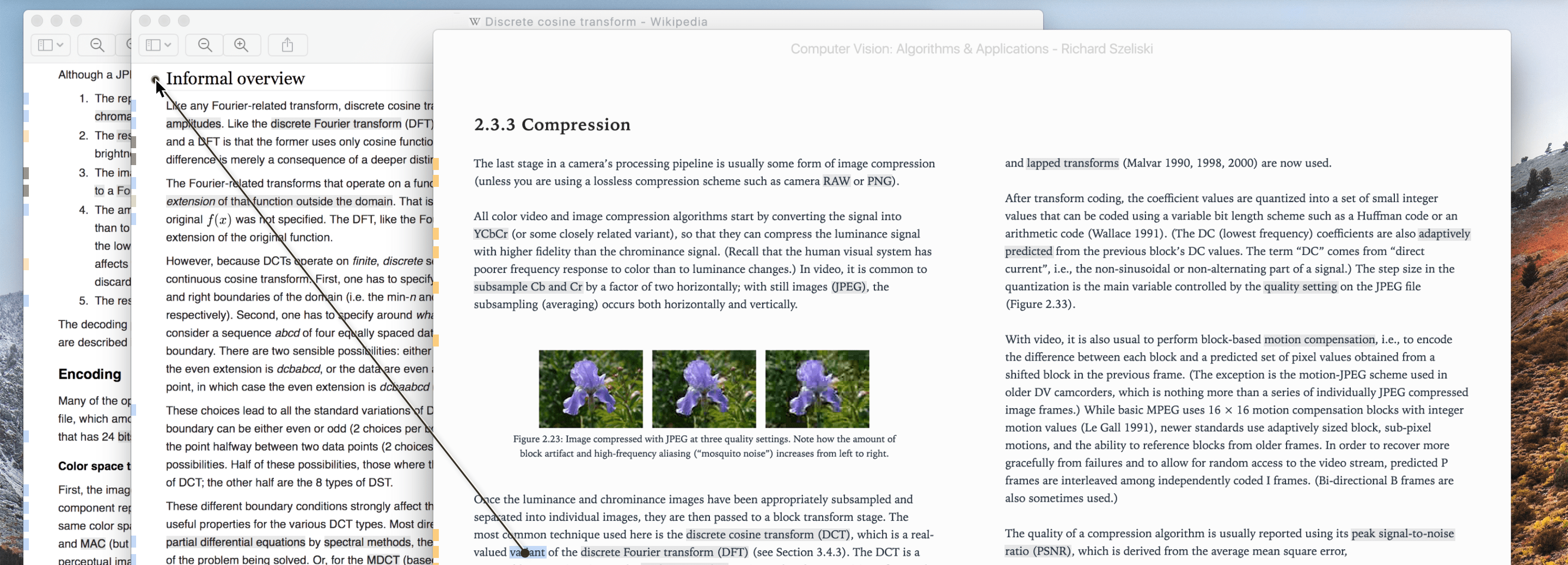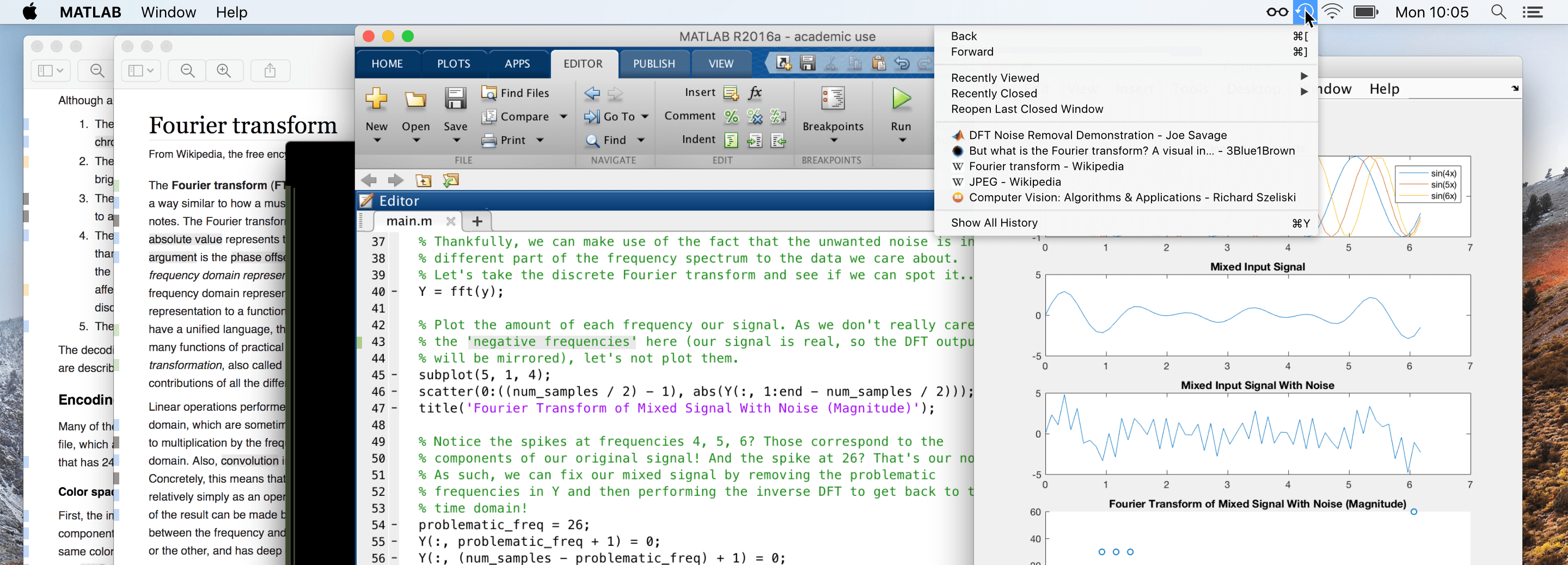Freeing the Web from the Browser
The Web is, without a doubt, the most powerful research tool currently available to man. No longer must researchers comb through endless indices and catalogues to find what they are looking for. Instead, hyperlinks allow users to associatively explore rich interconnected structures of information with ease. In just a few clicks, it is possible to navigate through a vast global space of information comprising documents on virtually any subject.
In spite of its tremendous improvements on what came before, however, the Web is frankly a disappointment in comparison to what it could be. Most saddening, perhaps, is the way in which the Web constrains the use of links. For example: although the link is the primary form of reference on the Web, underpinning the tangle of connections that make the system so useful, the ability to create new links is a privilege granted only to content producers. The vast majority of those interested in a piece of work are merely readers, unable to contribute, only to consume.
As a result, all link-based navigation on the Web today is constrained to the connections made by document authors. Think about that for a second. Billions across the globe rely on the Web to enhance their intellectual capabilities on a daily basis, building understanding through its rich mesh of connections. Yet when they open their Web browsers, these people are presented not with navigation opportunities carefully selected to aid them in finding the information they are looking for, but rather by the connections that the authors happened to make in crafting their documents.
The degree to which this constrains the Web is hard to overstate. Can we really expect authors to identify all salient connections from a piece of work to the wider Web? Even in writing these sentences about this very problem, I'm not thinking particularly hard about the links that I'm making. In fact, my focus has been almost exclusively on my writing. These past few paragraphs have been very much neglected in terms of their connective value, even despite the fact that there are some really sublime pieces of work relating to what I'm saying that you might find immense value in me pointing you towards.
Driving this point further, what about people that come to a piece of work with different backgrounds or for different reasons? The ideal set of links from this article for a non-technical reader, for instance, differs wildly to that for a systems programmer, which differs still to that for an HCI researcher. Different people have different perspectives on how information should be connected, so why do we not allow these range of perspectives to be represented and shared digitally? Why limit ourselves to just one point of view?
One could imagine a system in which multiple sets of links could be associated with a single resource to accommodate this, allowing for a range of different viewpoints on how things are connected. In such a system, connecting information together becomes a powerful tool available to all rather than a privilege granted only to content producers. Users are empowered to create and explore varying perspectives on information as they see fit. For instance, to better reflect their goals and motivations in consuming pieces of media, to connect ideas in works of mass media to areas that may have less widespread appeal, or to draw new relationships from historic works.
Further, links in such a system can serve as a powerful tool for building and externalising understanding. In researching the topic of this very article, for instance, I've had to read through and make connections between a great deal of existing research. Lacking a natural way to accomplish this, I've had to suffice with making these connections implicitly through plaintext notes — a process which is clunky at best.
Imagine a world in which I could instead effortlessly offload my understanding into the hypermedia system itself using links. A world in which I could construct and refine my own set of connections in a way that seamlessly integrates with my research process. My computer would serve as a powerful medium for thought, enabling me to better develop my understanding and to represent the results in a form that could be naturally navigated, manipulated, and shared.

The Past
As it turns out, these ideas aren't new. In fact, Vannevar Bush pondered the benefits of these kinds of capabilities way back in 1945 in his visionary essay As We May Think.
There is a new profession of trail blazers, those who find delight in the task of establishing useful trails through the enormous mass of the common record. The inheritance from the master becomes, not only his additions to the world’s record, but for his disciples the entire scaffolding by which they were erected. Vannevar Bush (As We May Think, 1945)
These ideas were also central to a movement within the hypermedia research community from the late ’80s to early ’00s known as open hypermedia. Unlike the WWW, open hypermedia systems make a hard separation between hypermedia structure — such as links and transclusions — and resource content. Links are stored completely separately from the content upon which they are to be displayed, and all hypermedia functionality — including creation of and interaction with links — is exposed via an open protocol implemented by an independent program called the ‘link server’.
This separation imbues these systems with a kind of flexibility that cannot be achieved with the Web today. The benefits of this are twofold. Firstly, these systems allow users to create and explore multiple perspectives on how information is connected, as we've already touched upon. In addition, though, by exposing hypermedia structure through an open protocol, any third-party program written to use the protocol can interact with the hypermedia system. That is, users are empowered to naturally explore information spaces that span the domains of multiple programs. After all, if connecting information is so powerful, why should we allow only a single, monolithic ‘browser’ program to have all the fun?

The Present
So… if these ideas have already been around for while, why do we not have these kinds of systems today? Well, I think there are a lot of reasons. No doubt the most important, though, is that open hypermedia systems require an astounding amount of design and engineering work, and in return offer benefits of unclear value. The Web today represents a local maxima in the solution space, and it's not at all clear if the effort required to move to a potentially better solution is worth the cost.
While a number of the technical details of these systems have been explored by existing research, what is really lacking — in my view — is research considering the human factors at play. What value can people extract from the unique capabilities of these systems? Do people find these capabilities useful? If so, how useful? And how should we design these systems to best serve users anyway? How should links from different sources be displayed? How should links be displayed across various types of media? How should history work in a multi-window hypermedia system? Can we replicate the organisational and navigational benefits of tabs in a system like this?
Frustrated by a lack of clarity around these questions, I set out to explore open hypermedia in more detail in the final year of my undergraduate studies at the University of Bath. Though I generally find myself more interested in systems programming than interaction design, I felt so strongly about the potential value of these systems that I couldn't help but try to do something about it.
The result is a roughly 200 page document entitled Freeing the Web from the Browser: Revisiting Open Hypermedia, which aims to both prove and improve the value of open hypermedia systems, and to encourage future work in this area. While I don't expect anyone to read through the document in its entirety, I do think it touches on some interesting ideas and goes some way to proving the immense value of these kinds of systems.
I'm particularly happy with the results of my exploratory study — in which participants had to sift through a great deal of information to understand the hex dump of a Mach-O executable — and the outcomes of my initial storyboarding efforts, which included a proposal for how chains of history could be separated in a multi-window hypermedia system using multiple desktops. I also produced a high-fidelity video prototype demonstrating the fundamentals of how link navigation and backtracking might work in these kinds of systems, which I've embedded below.
All in all, I really do think that these ideas represent significant improvements to the state of the art in hypermedia systems design. In order to make systems of this sort a reality, though, there is still much work to be done. Particularly in the area of interaction design. My work attempts to spark a wider discussion around these issues, but I certainly do not claim to have all the answers.
Though I don't believe that open hypermedia systems represent the ‘one true solution’ in this space, I do believe that they are a significant step in the right direction, and further that we're doing ourselves a great disservice by failing to consider these systems seriously. In the words of Doug Engelbart: “Any possibility for improving the effective utilization of the intellectual power of society’s problem solvers warrants the most serious consideration … man’s problem-solving capability represents possibly the most important resource possessed by a society”.